Squash bugs are notorious pests that can wreak havoc on gardens, particularly targeting squash, pumpkins, and other cucurbit crops. If you’re a gardener battling these critters, you might be wondering about their mobility: Do Squash Bugs Fly? Understanding this aspect of their behavior is key to effectively managing them. This article delves into the flying capabilities of squash bugs, along with their identification, life cycle, the damage they inflict, and proven strategies for control in both home gardens and farms.
Identifying Squash Bugs: What to Look For
Squash bugs, scientifically known as Anasa tristis, are relatively large insects with distinctive features that make them identifiable across their life stages.
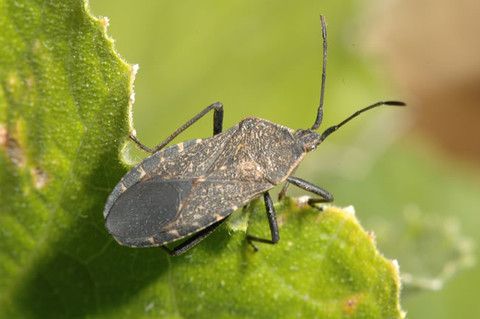 Adult squash bug, dark gray and flattened, on a green leaf
Adult squash bug, dark gray and flattened, on a green leaf
Adult Squash Bugs:
- Adult squash bugs are flattened and measure about 5/8 inch long.
- Their color ranges from dark gray to dark brown, providing excellent camouflage against soil and plant stems.
- A key identifying mark is their abdomen, which features alternating stripes of orange and brown, though this is usually hidden when viewed from above.
Squash Bug Eggs:
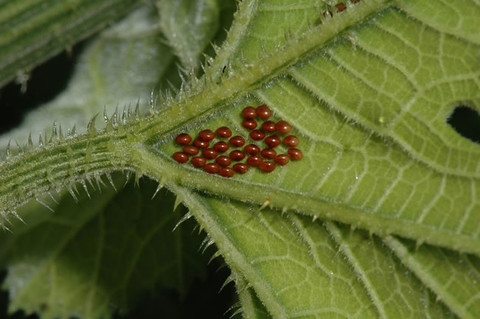 Cluster of bronze squash bug eggs laid in a V-shape on the underside of a leaf vein
Cluster of bronze squash bug eggs laid in a V-shape on the underside of a leaf vein
- Squash bug eggs are oval-shaped and quite small, about 1/16 inch long.
- They have a color that shifts from yellowish to bronze as they mature.
- Females typically lay eggs in clusters of around 20, often on the undersides of leaves, especially in the V-shape formed by leaf veins. They can also be found on stems.
Squash Bug Nymphs:
Squash bugs go through five nymph stages (instars) after hatching, changing in appearance as they grow.
 Newly hatched squash bug nymphs with light green abdomens and black heads
Newly hatched squash bug nymphs with light green abdomens and black heads
- Early Instars: Young nymphs are tiny, ranging from 1/10 inch long. They have a light green abdomen with black heads and legs.
- Later Instars: As nymphs grow, they increase in size up to 1/2 inch long. Their color transitions from light gray to brownish-gray, while their legs and antennae remain black.
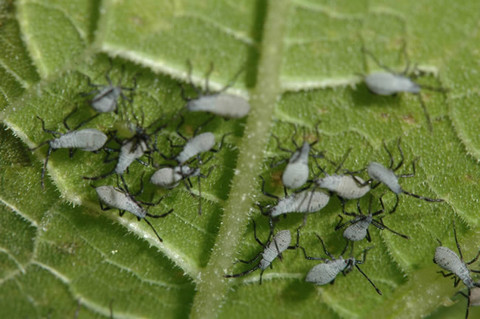 Squash bug nymphs in a later instar stage, showing a light gray coloration
Squash bug nymphs in a later instar stage, showing a light gray coloration
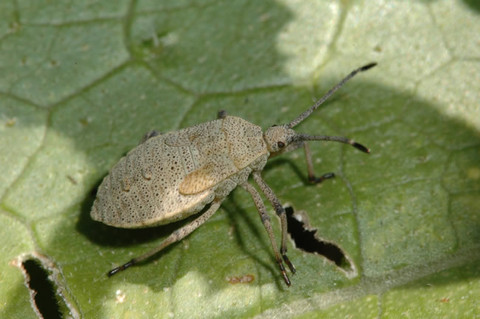 Mature squash bug nymph, brownish gray and nearing adult size
Mature squash bug nymph, brownish gray and nearing adult size
The Life Cycle of a Squash Bug: When Do They Fly?
Understanding the squash bug life cycle is crucial for targeted management. Adult squash bugs are indeed capable of flight, and this ability plays a significant role in their life cycle and infestation patterns.
Squash bugs overwinter as adults, seeking shelter in plant debris, under rocks, around buildings, and other protected spots. When spring arrives and temperatures warm, these adults emerge and fly to locate host plants in the cucurbit family. This initial flight is how they find and colonize gardens each year.
After finding host plants, adult squash bugs feed and mate. Females then begin laying eggs, typically starting in early June and continuing through mid-summer. Eggs hatch in about 10 days, and the nymphs emerge.
Nymphs go through their five instars over approximately four to six weeks. Throughout the nymph stages, they primarily crawl and are not capable of flight. Both nymphs and adults are adept at hiding under leaves, especially when disturbed.
There is generally one generation of squash bugs per year, although in warmer regions, a partial second generation might occur. All life stages can be present in a garden throughout the growing season. As fall approaches and cucurbit vines decline, adults and nymphs may congregate on squash fruits.
Finally, as temperatures drop, the nymphs die off, while the adults fly or crawl to sheltered overwintering sites, completing their annual cycle and preparing to re-emerge and fly again in the spring.
Damage Caused by Squash Bugs: Recognizing the Signs
Squash bugs are sap-sucking insects that primarily target squash and pumpkins. However, they can also infest other cucurbits like cucumbers and melons.
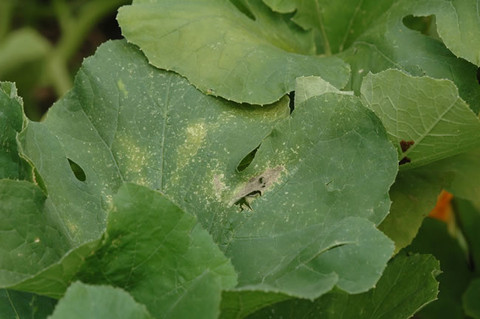 Yellow and brown spots on squash leaves indicating squash bug feeding damage
Yellow and brown spots on squash leaves indicating squash bug feeding damage
They use their piercing-sucking mouthparts to extract sap from leaves and stems. This feeding activity results in several noticeable symptoms:
- Yellow Spots: Initial feeding causes yellow spots to appear on leaves.
- Brown Spots: As feeding continues, these yellow spots turn brown and dry out.
- Wilting: Severe infestations can disrupt the flow of water and nutrients within the plant, leading to wilting, even when the soil is moist.
- Plant Death: Young seedlings and flowering plants are particularly vulnerable. Heavy squash bug feeding can cause young plants to wilt and die. Older, more established plants are more tolerant but can still suffer reduced yields.
It’s important to note that unlike cucumber beetles, squash bugs do not transmit plant diseases. The damage is directly caused by their feeding.
Managing Squash Bugs in Home Gardens
For home gardeners, a combination of non-chemical and, if necessary, targeted pesticide approaches can effectively manage squash bugs.
Cultural Controls
- Maintain Healthy Plants: Proper watering and fertilization promote vigorous plant growth, making them more resilient to squash bug damage.
- Remove Plant Debris: During the growing season, remove dead leaves and other debris to eliminate hiding places for squash bugs.
- Fall Cleanup: Thoroughly clean up garden beds in the fall, removing all cucurbit plant debris to reduce overwintering sites for adult squash bugs.
Physical Controls
- Crush Eggs: Regularly inspect the undersides of leaves and stems for egg clusters. Crush any eggs you find.
- Hand Removal: For small infestations, manually remove nymphs and adults. Drop them into a bucket of soapy water to kill them. This is most effective in the early morning or evening when squash bugs are less active.
- Trapping: Utilize traps by placing boards or newspaper pieces in the garden. Squash bugs will congregate underneath them overnight, seeking shelter. In the morning, lift the traps and collect and destroy the bugs.
Using Pesticides
In most home garden situations, insecticides are not necessary. If infestations are severe and physical controls are insufficient, targeted insecticide application may be considered as a last resort. Always choose products labeled for squash bug control and follow label instructions carefully, paying attention to pollinator protection.
Managing Squash Bugs on Farms
Commercial farms often face greater squash bug pressure, requiring a more integrated management approach.
Monitoring
- Scouting for Eggs: Begin scouting for egg masses in early summer (around July). Monitoring egg numbers helps predict nymph hatch and time control measures effectively.
- Treatment Threshold: Consider treatment if scouting reveals an average of one egg mass per plant.
- Hatch Timing: Remember that eggs hatch approximately 7-10 days after being laid, allowing a window for intervention.
Cultural Controls
- Crop Residue Removal: Squash bug adults overwinter in plant debris. Remove crop residues after harvest and keep field borders mowed and free of weeds and debris to minimize overwintering habitats.
- Avoid Straw Mulch: If squash bugs are a consistent problem, avoid using straw mulch, as it provides extra shelter for them, especially at night.
- Variety Selection: Some squash varieties exhibit greater tolerance to squash bug feeding. Butternut and buttercup squash, and sweet cheese pumpkins, are known to be more tolerant than other varieties.
- Trap Cropping: Employ trap crops like blue hubbard squash planted around the perimeter of the main crop. These can attract squash bugs away from valuable crops. Manage the trap crop by destroying eggs or applying insecticides if necessary to prevent it from becoming a squash bug breeding ground.
Physical Controls
- Egg Squashing During Scouting: While scouting for eggs, scrape them off leaves and squash them to reduce nymph populations.
Chemical Controls
- Target Nymphs: Chemical controls are most effective against nymphs, especially young nymphs. Time insecticide applications shortly after eggs hatch, based on scouting data.
- Spray Coverage: Nymphs often hide on the undersides of leaves, so ensure good spray coverage, reaching the lower leaf surfaces.
- Pollinator Protection: Be extremely mindful of pollinators when using insecticides, especially since vine crops are flowering when squash bugs are active. Select products and application timings that minimize risks to bees and other pollinators. Apply insecticides later in the day when flowers are closed and pollinator activity is reduced.
- Consult Resources: For specific insecticide recommendations and options, refer to resources like the Midwest Vegetable Production Guide for up-to-date information and best practices.
By understanding the life cycle and behavior of squash bugs, including their ability to fly, and implementing integrated management strategies, gardeners and farmers can effectively minimize damage and protect their cucurbit crops from these persistent pests.
Authors: Marissa Schuh, Extension educator, Jeffrey Hahn, retired Extension entomologist, and Suzanne Wold-Burkness, College of Food, Agricultural and Natural Resource Sciences
Reviewed in 2024